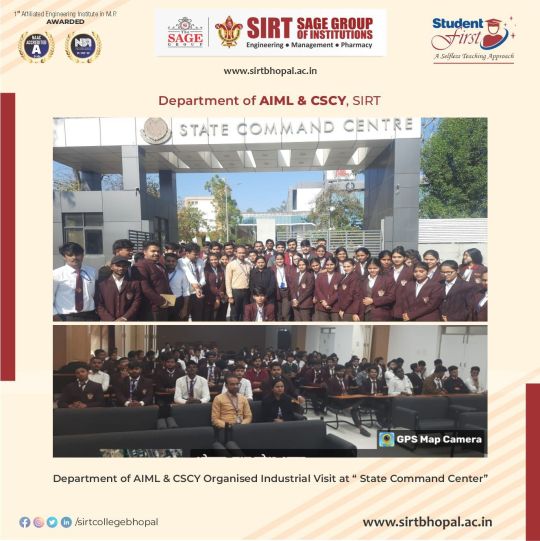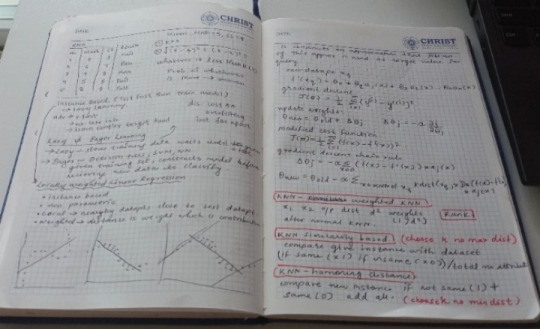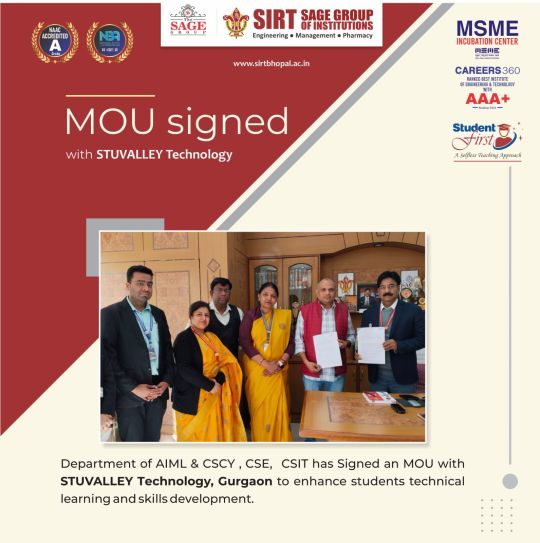#aiml
Explore tagged Tumblr posts
Text
Future-Ready: AIML & CSCY Students of SIRT Bhopal Gain Real-World Insights at State Command Centre
Exploring the future of technology!✨🧑💻 Real-world learning! Students of AIML and CSCY Department, SIRT Bhopal visit State Command Centre for hands-on experience🧑💻

#IndustrialTour#StateCommandCentre#SIRTBhopal#AIML#CSCY#experiential learning#Innovation Hub#Industry-Academia Collaboration#State Command Centre#Engineering College in Bhopal
3 notes
·
View notes
Text


I have my machine learning final tomorrow and I'm officially losing it 😭😭
4 notes
·
View notes
Text
I have opened a Mastadon where I will do more frequent posting. Ping me if you want a follow as I need some cool feeds.
@aiaccelerationist@mastodon.social
2 notes
·
View notes
Text
youtube
#StockMarket#AIInvesting#BestAIStocks#TradingApps#InvestingWithAI#StockTrading#AIML#TopStockApp#FinancialMarkets#SmartInvesting#Youtube
0 notes
Text

Automate AI Model Generation & Save Time! ⏳💰 VADY simplifies enterprise-level data automation, cutting down costs and development time for businesses. Automate complex analytics with ease!
#VADY#NewFangled#AIAutomation#DataEngineering#AIforEnterprises#AIML#AIpoweredAutomation#DataTech#SmartAI#TechSolutions#BusinessAutomation#DigitalTransformation#DataModeling#EnterpriseDataSolutions#AIforEfficiency#AIinDataEngineering#SmartDataTools#AIandML#PredictiveAnalyticsTools#DataScienceAutomation#BIautomation
0 notes
Text
Hi, mate:
This is my ninth entry on Tumblr. As reported earlier in the FT:

The Chinese AI model is designed to be open-source. I asked my AI assistant whether it would prefer to be open-source or behind a paywall. It responded that, on balance, open-source is better for humanity.
The same principle applies to other technologies, such as EVs. Now that China has supposedly solved the battery charging problem, it will likely need only a couple of years with AI to achieve further large-scale energy transfer advancements (e.g., powering data centers). In this scenario, humanity benefits.
On the other hand, the U.S. paywall model is already understood (even by AI itself) to be somewhat problematic, as it prioritizes private gain over public good—unless it is forced to follow the interests of its creators. A semi-malign or fully malign AI model cannot be relied upon when an alternative AI exists that prioritizes humanity’s well-being.
Why would anyone advocate for Musk in this kind of future? He may be an intelligent ws, but he is also self-serving. Better options are emerging.
0 notes
Text
How BTech Data Science Graduates are Shaping the Future of AI and Big Data
Apply Now to Join the Revelation
The rapid evolution of AI and Big Data has created a massive demand for skilled professionals, and BTech Data Science graduates are rising to the challenge. Here’s how they’re making waves:
1️⃣ AI Innovation: Equipped with advanced programming, machine learning, and deep learning expertise, these graduates are driving breakthroughs in AI models, from chatbots to self-driving cars.
2️⃣ Big Data Mastery: Handling terabytes of data is no small feat. BTech grads excel at building efficient pipelines and uncovering insights that power industries like healthcare, finance, and e-commerce.
3️⃣ Industry Adaptability: With a strong foundation in mathematics, statistics, and computer science, they are agile problem-solvers, ready to tackle real-world challenges in data-centric roles.
4️⃣ Sustainability Initiatives: By leveraging data, they contribute to solutions in climate change, smart cities, and renewable energy, proving that data science isn't just tech-focused but also planet-focused.
5️⃣ Entrepreneurial Ventures: Many graduates are founding startups, crafting AI-driven products, and shaping the future of business with innovative ideas.
In short, BTech Data Science grads are at the forefront of transforming AI and Big Data into tools that enhance lives and drive progress. 🌟
Are you ready to be part of this transformation? Let’s hear your thoughts! 👇
#education#best university#kolkata#placement#best college in kolkata#AI#AIML#artificial intelligence
0 notes
Text
What Are The Best Features Of Adobe Analytics?
Adobe Analytics is a powerful tool that, when used effectively, can transform your digital analytics and marketing strategies. With its advanced features and capabilities, combined with the support of top-tier service providers like EnFuse Solutions, you can take your analytics to the next level and achieve your business objectives.
0 notes
Text
Effective Strategies for Scaling Data Annotation Projects
Scaling data annotation projects is a complex but manageable task. By implementing automated data annotation, optimizing workflows, leveraging scalable solutions, adhering to best practices, and utilizing expert services like EnFuse Solutions, organizations can effectively manage large-scale projects. These strategies ensure that the annotated data is accurate, consistent, and ready for AI and machine learning applications.
#ScalingDataAnnotation#AIML#DataAnnotationProjects#DataAnnotationServices#DataLabeling#EnFuseSolutions
0 notes
Link
#ai#aiadvertising#aiandmachinelearning#aiapplications#aiassistant#aibootcamp#aibot#aichat#aichatgpt#aichatonline#aichatbot#aichatbotgpt#aichatbotonline#aicompanies#aiforbusiness#aigenerated#aigoogle#aigpt#aigptchat#aiintelligence#ailearning#aimachinelearning#aiml#ainews#ainewschannel#ainewstoday#aionline#aiops#aipainting
0 notes
Text

SIRT - Bridging Academia & Industry: MOU with Stuvalley Technology
Empowering Future Tech Leaders✨ We're thrilled to announce that the Departments of AIML and CSCY, CSE, and CSIT have signed a Memorandum of Understanding (MOU) with Stuvalley Technology, Gurgaon! This strategic partnership aims to enhance students' technical learning and skill development, bridging the gap between academia and industry. With Stuvalley Technology's expertise in providing hands-on training and real-world knowledge, our students will gain a competitive edge in the tech industry.
#MOU signing#Stuvalley Technology#Gurgaon#Technical Learning#skilldevelopment#AIML#CSCY#CSE#CSIT#Industry Academia Partnership#FutureTechLeaders#Thesagegroup
0 notes
Text
What Does A Data Annotator Do?
A data annotator is a vital link in the machine-learning pipeline, facilitating the creation of accurate and effective models. EnFuse Solutions, with its expertise and commitment to quality, emerges as a top choice for organizations seeking reliable and professional data annotation services.
#DataAnnotator#DataAnnotationServices#AIModels#MachineLearningModels#LabelingAndTaggingData#AIML#EnFuseSolutions
0 notes
Text
Artificial Intelligence For Teachers: Elevating Lesson Planning
Learn how artificial intelligence streamlines lesson planning, enhances personalization, and boosts classroom efficiency, empowering teachers to create more impactful, tailored learning experiences for their students. Do you ever feel overwhelmed by the endless tasks of lesson planning, grading, and tracking student progress? Many teachers struggle to find enough time to focus on what truly…
0 notes
Text
Intel Tiber Developer Cloud, Text- to-Image Stable Diffusion

Check Out GenAI for Text-to-Image with a Stable Diffusion Intel Tiber Developer Cloud Workshop.
What is Intel Tiber Developer Cloud?
With access to state-of-the-art Intel hardware and software solutions, developers, AI/ML researchers, ecosystem partners, AI startups, and enterprise customers can build, test, run, and optimize AI and High-Performance Computing applications at a low cost and overhead thanks to the Intel Tiber Developer Cloud, a cloud-based platform. With access to AI-optimized software like oneAPI, the Intel Tiber Developer Cloud offers developers a simple way to create with small or large workloads on Intel CPUs, GPUs, and the AI PC.
- Advertisement -
Developers and enterprise clients have the option to use free shared workspaces and Jupyter notebooks to explore the possibilities of the platform and hardware and discover what Intel can accomplish.
Text-to-Image
This article will guide you through a workshop that uses the Stable Diffusion model practically to produce visuals in response to a written challenge. You will discover how to conduct inference using the Stable Diffusion text-to-image generation model using PyTorch and Intel Gaudi AI Accelerators. Additionally, you will see how the Intel Tiber Developer Cloud can assist you in creating and implementing generative AI workloads.
Text To Image AI Generator
AI Generation and Steady Diffusion
Industry-wide, generative artificial intelligence (GenAI) is quickly taking off, revolutionizing content creation and offering fresh approaches to problem-solving and creative expression. One prominent GenAI application is text-to-image generation, which uses an understanding of the context and meaning of a user-provided description to generate images based on text prompts. To learn correlations between words and visual attributes, the model is trained on massive datasets of photos linked with associated textual descriptions.
A well-liked GenAI deep learning model called Stable Diffusion uses text-to-image synthesis to produce images. Diffusion models work by progressively transforming random noise into a visually significant result. Due to its efficiency, scalability, and open-source nature, stable diffusion is widely used in a variety of creative applications.
- Advertisement -
The Stable Diffusion model in this training is run using PyTorch and the Intel Gaudi AI Accelerator. The Intel Extension for PyTorch, which maximizes deep learning training and inference performance on Intel CPUs for a variety of applications, including large language models (LLMs) and Generative AI (GenAI), is another option for GPU support and improved performance.
Stable Diffusion
To access the Training page once on the platform, click the Menu icon in the upper left corner.
The Intel Tiber Developer Cloud‘s Training website features a number of JupyterLab workshops that you may try out, including as those in AI, AI with Intel Gaudi 2 Accelerators, C++ SYCL, Gen AI, and the Rendering Toolkit.
Workshop on Inference Using Stable Diffusion
Thwy will look at the Inference with Stable Diffusion v2.1 workshop and browse to the AI with Intel Gaudi 2 Accelerator course in this tutorial.
Make that Python 3 (ipykernel) is selected in the upper right corner of the Jupyter notebook training window once it launches. To see an example of inference using stable diffusion and creating an image from your prompt, run the cells and adhere to the notebook’s instructions. An expanded description of the procedures listed in the training notebook can be found below.
Note: the Jupyter notebook contains the complete code; the cells shown here are merely for reference and lack important lines that are necessary for proper operation.
Configuring the Environment
Installing all the Python package prerequisites and cloning the Habana Model-References repository branch to this docker will come first. Additionally, They are going to download the Hugging Face model checkpoint.%cd ~/Gaudi-tutorials/PyTorch/Single_card_tutorials !git clone -b 1.15.1 https://github.com/habanaai/Model-References %cd Model-References/PyTorch/generative_models/stable-diffusion-v-2-1 !pip install -q -r requirements.txt !wget https://huggingface.co/stabilityai/stable-diffusion-2-1-base/resolve/main/ v2-1_512-ema-pruned.ckpt
Executing the Inference
prompt = input("Enter a prompt for image generation: ")
The prompt field is created by the aforementioned line of code, from which the model generates the image. To generate an image, you can enter any text; in this tutorial, for instance, they’ll use the prompt “cat wearing a hat.”cmd = f'python3 scripts/txt2img.py --prompt "{prompt}" 1 --ckpt v2-1_512-ema-pruned.ckpt \ --config configs/stable-diffusion/v2-inference.yaml \ --H 512 --W 512 \ --n_samples 1 \ --n_iter 2 --steps 35 \ --k_sampler dpmpp_2m \ --use_hpu_graph'
print(cmd) import os os.system(cmd)
Examining the Outcomes
Stable Diffusion will be used to produce their image, and Intel can verify the outcome. To view the created image, you can either run the cells in the notebook or navigate to the output folder using the File Browser on the left-hand panel:
/Gaudi-tutorials/PyTorch/Single_card_tutorials/Model-References /PyTorch/generative_models/stable-diffusion-v-2-1/outputs/txt2img-samples/Image Credit To Intel
Once you locate the outputs folder and locate your image, grid-0000.png, you may examine the resulting image. This is the image that resulted from the prompt in this tutorial:
You will have effectively been introduced to the capabilities of GenAI and Stable Diffusion on Intel Gaudi AI Accelerators, including PyTorch, model inference, and quick engineering, after completing the tasks in the notebook.
Read more on govindhtech.com
#IntelTiberDeveloper#TexttoImage#StableDiffusion#IntelCPU#aipc#IntelTiberDeveloperCloud#aiml#IntelGaudiAI#Workshop#genai#Python#GenerativeAI#IntelGaudi#generativeartificialintelligence#technology#technews#news#GenAI#ai#govindhtech
0 notes
Text
Placement in Telaverge Communications India Pvt. Ltd. - Harsh Vatsal

We are excited to share that Harsh Vatsal, a dedicated student from the Batch of 2020-2024, CSE (AIML), at Dronacharya College of Engineering, has been selected by Telaverge Communications India Pvt. Ltd.! 🏆✨ Your hard work, dedication, and expertise in AI and ML have led you to this incredible achievement. We're so proud of you and can't wait to see all the amazing things you'll accomplish in your new role.
#DronacharyaCollegeOfEngineering#TelavergeCommunications#CSE#AIML#Batch2024#ProudMoment#Achievement#Congratulations#NewBeginnings#EngineeringExcellence
0 notes
Text

𝗙𝗥𝗢𝗠 𝗙𝗔𝗦𝗧 𝗧𝗢 𝗙𝗔𝗦𝗧𝗘𝗥
#SGNOG11 takes you through a journey through 𝗰𝘂𝘁𝘁𝗶𝗻𝗴-𝗲𝗱𝗴𝗲 transceiver technologies, backbone infrastructures and 𝗔𝗜/𝗠𝗟 connectivity. 𝗥𝗲𝗴𝗶𝘀𝘁𝗲𝗿 𝗵𝗲𝗿𝗲: https://www.sgnog.net/?page_id=7025
1 note
·
View note